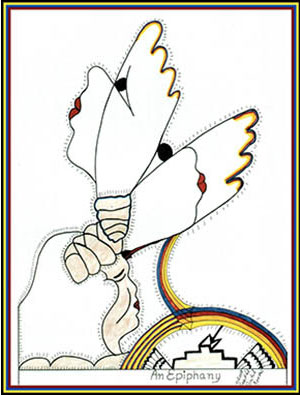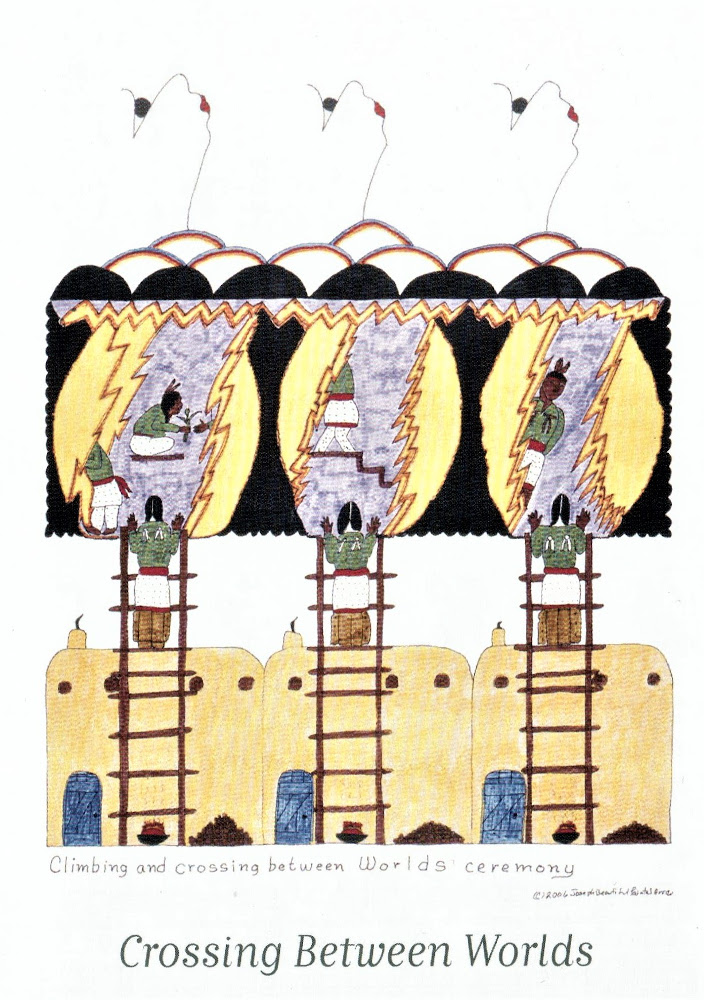Beautiful Painted Arrow
Joseph Rael, known by the spiritual name Beautiful Painted Arrow, is a revered figure in contemporary Native American spirituality — a shaman, writer, ceremonial dancer, and visionary artist who has spent his life creating bridges between ancient traditions and the modern world. Born in 1935 to a Picuris Pueblo father and a Ute mother, Rael’s early life was steeped in the rich cultural, linguistic, and spiritual heritage of the Southwest. Raised on the Southern Ute reservation in southern Colorado, he was immersed in ceremony from a young age, learning not only the customs of his people but the deeper meanings carried in story, sound, and silence.
The name Beautiful Painted Arrow was given to him as a child and became the foundation for his role as a spiritual messenger. In many Native traditions, names received in ceremony carry deep meaning — they are not merely labels, but expressions of energetic resonance and vibration. His name speaks to a life guided by awareness, intention, and prayer. To carry such a name is to carry a responsibility: to live in service of the sacred, and to do so with beauty, purpose, and direction.
Throughout his life, Rael has honored that responsibility with humility and insight. His teachings do not arise from abstract philosophies but from a lived experience of ceremony and vision. He often says that life itself is a ceremony — that every step we take, every breath we draw, can be sacred if we bring awareness to it. This understanding has shaped not only his personal path but also the way he shares wisdom with others.
As he began traveling and teaching, Rael shared the depth of his cultural and spiritual knowledge in a way that resonated across borders and traditions. His work spans continents, languages, and spiritual lineages, yet it remains firmly grounded in the values of his Pueblo roots. Whether speaking to Native communities, guiding workshops, or helping to create ceremonial spaces, Rael continues to express one central message: we are vibrational beings, and life itself is an unfolding interplay of breath, matter, and movement.
Joseph Rael’s ability to communicate profound truths in accessible language has made his teachings relevant for people of many backgrounds. He invites us not to become something we are not, but to return to what we have always been — beings of frequency, breath, and consciousness. His stories, visions, and ceremonial practices serve as doorways into a deeper way of being, one that honors both individual awakening and collective harmony.
As we move into the next section, we’ll explore how Joseph Rael has carried these life teachings into form — through books that breathe with spirit, artwork that channels sacred patterns, and the vibrational language of the Sacred Vowels. Together, these offerings form a living body of work that continues to guide people toward healing, insight, and the remembrance of the sacred in all things.

Beautiful Painted Arrow

in a new light.”
Literary and Artistic Endeavors
Joseph Rael’s teachings come to life through many forms — most notably his books, visual art, ceremonial dances, and sound practices. Each medium serves as a channel through which his spiritual insights are shared, allowing people to engage not only intellectually, but experientially. Whether on the page, the canvas, or in the air through vibration, Rael’s work invites us into a deeper relationship with ourselves, the earth, and the sacred forces that guide all life.
His books are often described as living transmissions. Titles like Being & Vibration, House of Shattering Light, and Tracks of Dancing Light are not just written texts; they are ceremonial teachings in literary form. With poetic rhythm and metaphor, Rael blends his personal experiences, Tiwa traditions, and visionary messages into a language that touches the soul. The reader is not just absorbing ideas — they are being called to remember. His stories and teachings evoke a sense of recognition, as if the wisdom was already within us, waiting to be reawakened.
Central to many of his writings is the use of the Tiwa language, the sacred tongue of his father’s people. Rael believed that Tiwa carried more than meaning — it carried vibration. When spoken or chanted, it activated something beyond the intellect. By weaving Tiwa words into English texts, he opened a space for readers to encounter the world through a different resonance — one shaped by sound, rhythm, and the natural order of the cosmos.
That same resonance is found in Rael’s visual art. His paintings and drawings are rich with sacred geometry, elemental symbols, and spirit beings. These images are not simply aesthetic; they are invitations to contemplation, meditation, and inner journeying. Repeating patterns, spirals, and circles reflect the cyclical nature of time and consciousness. In Rael’s view, nothing is separate — everything is in motion, vibrating, spiraling, and returning to source.
Perhaps the most unique and powerful aspect of Rael’s teachings lies in his work with Sacred Vowels. According to him, each vowel sound corresponds to a specific direction, color, element, and state of awareness. These sounds are more than tones — they are keys to attunement, capable of shifting consciousness and aligning the human body with universal energies. When chanted in a ceremonial setting or during personal meditation, the vowels become vibrational tools that can unlock insight, restore balance, and connect the individual to something greater than themselves.
Together, Joseph Rael’s writings, artwork, and sound practices form a unified body of spiritual teaching — one that transcends any single tradition or belief system. His message is both inclusive and elemental: life is breath, matter, and movement, and each of us holds the power to return to our own vibrational essence.
Sacred Vowels² at a Glance
A
aah
Purification, Direction of the East, Mental Body
E
eh
Relationship, Direction of the South, Emotional Body
I
eee
Awareness, Direction of the West, Physical Body
O
oh
Innocence, the Infinite Void; Direction of the North, Spiritual Body
U
uu
Carrying, Center of the Medicine Wheel
Sound and Peace Chambers
Joseph Rael’s teachings take form not only in words and symbols but also in spaces designed for healing and connection. Among his most enduring contributions are the Sound and Peace Chambers — sacred, kiva-like structures envisioned through a series of powerful spiritual experiences in the mid-1980s. Guided by these visions, Rael was shown how sound could be used not just as a personal healing tool, but as a collective medicine for humanity and the Earth.
Since then, Sound and Peace Chambers have been built around the world — in the United States, Canada, South America, Europe, and beyond. Though each structure is unique to its land and caretakers, they all follow the ceremonial guidelines Rael originally received. These are not passive monuments; they are spaces of prayer, chanting, and spiritual resonance, where people from all walks of life come together to remember and realign with the sacred.
Inside the chamber, ceremonies often focus on chanting the Sacred Vowels — a core element of Rael’s teachings. Each vowel carries a specific vibrational frequency and corresponds with a direction, a color, and a deeper spiritual quality. When chanted intentionally, these sounds are believed to awaken inner awareness and harmonize the body with larger natural forces. The simplicity of the practice makes it accessible to anyone, while the depth of the experience can be profound and life-changing.


Sound and Peace Chambers also serve as spaces for silence and reflection — places to sit with the deep questions of life and be held by a container of resonance and intention. They are maintained by local communities and keepers who continue Joseph’s vision of global healing through sound and shared intention. While each gathering is unique, the spirit of the work remains rooted in connection — to the land, to one another, and to something greater than ourselves.
Though the idea of the Fifth World is present in Rael’s teachings — often symbolizing a shift toward deeper harmony and spiritual consciousness — it is not the sole focus of his legacy. Instead, what endures is his call to live vibrationally: to speak, move, and act from a place of centered awareness, where sound and silence are both honored.
In recent years, Joseph Rael has retired from active teaching. His voice, once a guiding presence at gatherings, continues to resonate through his many books, artworks, and the practice of Sacred Vowel chanting. His daughter, Geraldine Rael, now carries the torch of this lineage. With reverence and care, she shares his teachings with new generations, ensuring that his vision lives on — not frozen in the past, but evolving as a living tradition.
Joseph Rael’s work reminds us that peace is not a far-off destination but a practice — one that begins within and ripples outward through sound, ceremony, and community. Through the Sound and Peace Chambers, through his daughter’s continued teaching, and through each of us who listen with our hearts, the vibration he set in motion continues to hum.
Honoring Joseph Fire Crow and Joe Medicine Crow
As we explore the work of Joseph Rael, it feels important to honor those who have shared their wisdom and enriched this path.
With deep gratitude, I acknowledge Joseph Fire Crow and Joe Medicine Crow, two extraordinary individuals I’ve been fortunate to connect with — both online and in Spirit.
Joseph Fire Crow
Joseph Fire Crow, a celebrated Cheyenne flutist, profoundly impacted many through his music. Born on the Northern Cheyenne Reservation in southwestern Montana, he devoted his life to mastering the Native American flute, a symbol of Cheyenne heritage. His music, a harmonious blend of traditional and modern styles, resonated deeply with the essence of Native American spirituality. Recognized for his significant contributions to Native American music, Fire Crow received multiple accolades, including a Grammy nomination.
Discover more about Joseph Fire Crow and his musical legacy at his official website.
Joe Medicine Crow
Joe Medicine Crow was an esteemed Crow tribal historian, author, and the last war chief of the Crow Nation. Born in 1913, his life formed a direct link to the Battle of Little Bighorn, with his grandfather serving as a scout for General Custer. A World War II veteran with a Master’s degree in anthropology, Medicine Crow was honored with the Presidential Medal of Freedom for his dedication to preserving and sharing the history and culture of the Crow people.
Explore more about Joe Medicine Crow’s life and work through this resource.
1. https://en.wikipedia.org/wiki/Joseph_Rael
2. Kopacz & Rael. Walking the Medicine Wheel: Healing Trauma and PTSD. Millichap Books/Pointer Oak, 2016
